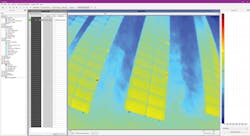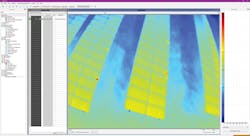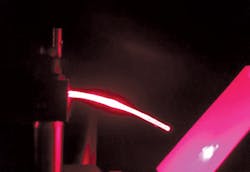Machine-vision innovations offer top-down, inside-out views
Think “machine vision” in the context of electronics design and manufacturing, and you might think of automated optical inspection for printed-circuit boards. Indeed, there have been advances on that front. As this issue goes to press in early November, Orbotech Ltd. is introducing the Ultra Dimension automated optical inspection (AOI) series for PCB production. The company reports that the Ultra Dimension is the first AOI solution to integrate four leading solutions—pattern inspection, laser via inspection, remote multi-image verification, and 2D metrology—into a single system.
Our February print issue will delve into the Ultra Dimension and other systems aimed at PCB inspection and test, and it will preview IPC Apex Expo, scheduled for Feb. 24 through March 1 in San Diego. Meanwhile, two other machine-vision innovations are worth a look. One can literally be described as high-flying; the other supports an inside-out view of the human body.
Photovoltaic inspection
First, EVT Eye Vision Technology, based in Karlsruhe, Germany, cites the growing market for photovoltaic systems, with 1.5 million installed in Germany alone at the end of 2014. The market growth is driving the demand for efficient quality-assessment tools.
The company explains that the thermal camera is an established research-and-development tool for monitoring solar cells and modules. But increasingly, uncooled thermal-imaging cameras are supporting solar-module quality control outside the lab—for preventative maintenance, for example.
EVT reports portable thermal-imaging cameras are usually equipped with an uncooled microbolometer-detector, which works in a wave range of 8 to 14 µm. But in this spectral range, glass is not transparent. Because the thermal camera captures the heat distribution directly on the glass surface, the heat distribution on the cells below is only measured indirectly. The differences can be small, but to make them visible, the suitable thermal imaging cameras need a thermal sensitivity of ≤ 0.08 K.
EVT offers with its EyeCheck Thermo intelligent smart camera as a suitable instrument for such applications. Mounted on a drone, it can fly over the solar panels being inspected (Figure 1). The camera comes with EyeVision software, which allows users to set a threshold temperature that corresponds to their systems developing a fault. The software generates an error message if any temperatures above this threshold occurs, allowing users to respond immediately.
Courtesy of EVT Eye Vision Technology
Peering into the human body
While the drone-mounted EyeCheck Thermo offers aerial views, another recent innovation addresses vision from a decidedly different perspective. It aims to assist with optical imaging within the human body. At Penn State’s Materials Research Institute, an electrical engineer and a biomaterials engineer have teamed up to develop a flexible, biodegradable optical fiber to deliver light into the body for medical applications.
“The problem is that visible light can only penetrate to a certain depth, maybe hundreds of microns,” said Jian Yang, professor of biomedical engineering at Penn State. “Near infrared light might be able to penetrate a few millimeters to a centimeter, but that is not enough to see what is going on.”1
Courtesy of D. Shan/C. Zhang/Penn State
Glass fiber can get light into biological tissue at greater depths, but glass is brittle and not biodegradable. As an alternative, Yang had previously invented a polymer based on citrate that he developed as a general platform for biomedical applications, such as biodegradable screws for bone fixation, scaffolds for tissue engineering, and nanoparticles for delivering time-released drugs. Now, he is collaborating with Zhiwen Liu, Penn State professor of electrical engineering, on using Yang’s citrate-based polymer to create a step-index optical fiber for light delivery inside the body.
A step-index fiber has a core material that transmits the light and a cladding that protects the core and keeps the light from escaping. Yang’s lab makes and tests the polymer and then takes it to Liu’s lab to turn it into a fiber. Once the fiber is tested and fine-tuned, Yang’s lab implants it in biological tissue for testing.
“Because the material is nontoxic and biodegradable, the citrate-based fiber could be left inside the body for long periods without the need for a second surgery to remove it,” Yang explained. “In addition to sensing and imaging, we can add therapeutic chemicals, drugs, or biological molecules for disease treatment.”
Reference
- “A Safe Optical Fiber for Delivering Light and Drugs Into the Body,” Newswise, Oct. 9, 2017.
For more information:
About the Author

Rick Nelson
Contributing Editor
Rick is currently Contributing Technical Editor. He was Executive Editor for EE in 2011-2018. Previously he served on several publications, including EDN and Vision Systems Design, and has received awards for signed editorials from the American Society of Business Publication Editors. He began as a design engineer at General Electric and Litton Industries and earned a BSEE degree from Penn State.


